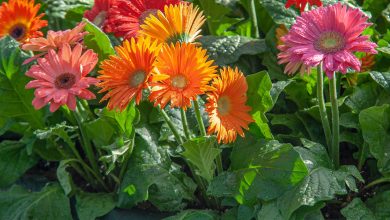Liquidambar Styraciflua: [Planting, Care, Irrigation, Substrate, Pests]
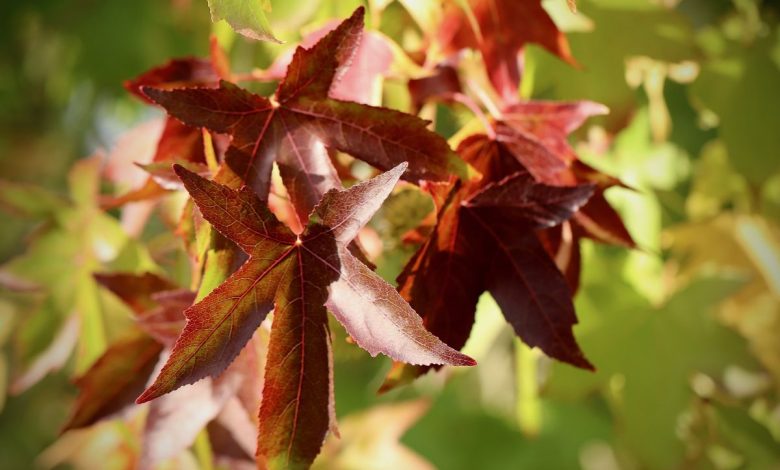
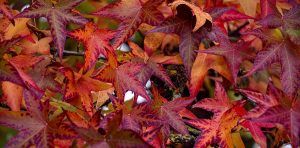 Liquidambar styraciflua, also known as Liquidambar, Amber Tree, Estoraque, Ocozol, Storaque Tree.
Liquidambar styraciflua, also known as Liquidambar, Amber Tree, Estoraque, Ocozol, Storaque Tree.
It is a deciduous tree of the genus Liquidambar native to the warm temperate zones of eastern North America and the tropical mountainous regions of Mexico and Central America.
Liquidambar Styraciflua is one of the major valuable forest trees in the southeastern United States, and is a popular ornamental tree in temperate climates.
It is recognized by the combination of its five-pointed star-shaped leaves and its hard, pointed fruits.
Few trees are as spectacular as Liquidambar Styraciflua in the fall.
It is currently classified in the plant family Altingiaceae, but was previously considered a member of the Hamamelidaceae.
Important points when sowing a Liquidambar Styraciflua
- Origin: North America and Central America.
- Leaf type: deciduous.
- When does it bloom? During the spring.
- What lighting needs do you have? Sow in a place with lots of light, preferably.
- Approximate height: Between 15 and 40 meters.
- It can be considered a fast growing tree.
- It can be considered an ornamental tree.
- It is extremely resistant to cold. No to drought.
- Pruning, although it sometimes favors it, is not essential.
Characteristics of Liquidambar Styraciflua
Size
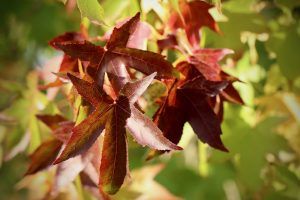
Liquidambar styraciflua is a medium to large sized tree, growing to 15–21 m in cultivation and up to 46 m in the wild, with a trunk up to 0.61–0.91 m in diameter, on average.
These trees can live up to 400 years!
The tree has a symmetrical shape and an egg-shaped crown, when the branches become too heavy after its first two years of cultivation.
small branches
Another distinctive feature of the tree is the peculiar appearance of its small branches and twigs.
The bark adheres to these in edge plates rather than laterally, and with a little imagination, a piece of the leafless branch easily takes on a reptile shape; in fact, the tree is sometimes called «alligator wood.»
The bark is light brown tinged with red and sometimes gray with dark streaks. It is deeply fissured with scaly ridges. The branches carry layers of cork.
The branches are very short, many-angled, winged, and at first covered with rusty hairs, eventually turning reddish brown, gray, or dark brown.
As an ornamental tree, Liquidambar styraciflua has a drawback: the branches can have ridges or «wings» that form more surface area, increasing the weight due to the accumulation of snow and ice on the tree.
However, the wood is heavy and hard with an interlocking grain, but it is difficult to season.
Liquidambar styraciflua flowers
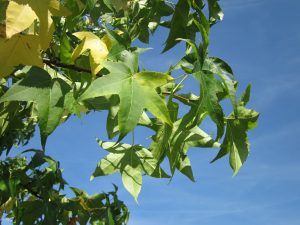 Flowers usually appear in spring and persist through fall/autumn, sometimes persisting into winter.
Flowers usually appear in spring and persist through fall/autumn, sometimes persisting into winter.
They are usually 25-38 mm in diameter and covered with oxidized hairs.
The flowers are unisexual and greenish in color. The flowers are staminate in terminal clusters two to three inches long, the pistil in a solitary head on a slender peduncle carried on the axis of an upper leaf.
The staminate flowers are devoid of calyx and corolla, but are surrounded by hairy bracts.
Stamens indefinite; short filaments; intrusive anthers. Pistillate flowers with a two-celled, two-spiked ovary , the carpels produced in a long, curved, persistent style.
The ovaries are more or less united and harden into the fruit. There are many ovules but few mature.
How do we prepare the land?
It is important that the soil drains properly and the water does not easily puddle.
We are interested in it being acidic, that is, with a pH between 4 and 6.
How often do we water?
During the first months and years the liquidambar styraciflua needs humidity. Especially in summer.
At first, water practically every day if it’s hot and in winter every 2-3 days.
We recommend drip irrigation.
Planting a Liquidambar styraciflua step by step
- Obtain sweetgum seeds in late fall after the spiny, round seed pods mature to a solid light brown color. Collect seed pods directly from the tree instead of picking them from the ground, because fallen pods may be infested by insects or fungi.
- Place sweetgum seed pods inside a paper bag.
- Close the top of the bag. Place them in a warm, dry place for three to 10 days, or until the pods drop their seeds.
- Shake the bag periodically to help the seeds move.
- Soak sweetgum seeds in a bowl of water overnight to determine which ones are viable. Discard any seeds that float to the top of the water. Scoop out the seeds that sink to the bottom. Put them to dry on a sheet of newspaper while you prepare the containers.
- Fill the pots initially with sterile compost.
- Sow a sweetgum seed in each pot. Press onto the surface of the compost. Cover the seed with a layer of coarse sand.
- Spray the sand heavily to settle it.
- Wrap each starter pot in a clear plastic sandwich bag. Store the pots in the fridge for a month to cold stratify the seeds. Spray the seeds when the compost and sand are moist below the surface.
- Move the starter pots into a lightly shaded, insulated cold frame or indoors near a large window after the cold stratification period is over.
- Continue watering the sweetgum seeds as long as the compost is slightly moist below the surface. Use a sprayer to water the seeds, as a heavier stream of water will remove them from the soil.
- Look for the first sweetgum seedlings by waiting two to four weeks.
- Transplant the seedlings into individual containers filled with potting soil four weeks after germination.
- Grow sweetgum seedlings in a well-lit, sheltered spot outdoors with morning and afternoon sun.
- Acclimate them to direct sunlight for a week in late summer.
- Transplant sweetgums into the ground in autumn after the first rains. Choose a sunny planting spot with fairly moist, fast-draining soil. Give it water during the dry season in its first year.
Liquidambar styraciflua care
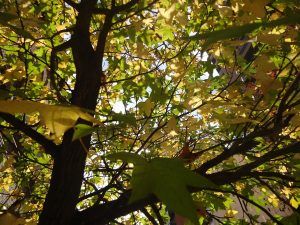 Be careful if you have grass and the fruits fall. As the mower passes by, they can bounce back hard and hurt you. It is advisable to scrape previously.
Be careful if you have grass and the fruits fall. As the mower passes by, they can bounce back hard and hurt you. It is advisable to scrape previously.
On the other hand, liquidambar styraciflua is pruned before flowering. Those dead branches are removed and the interior of the tree is aerated.
Otherwise, this tree does not need much more care.
Plagues and diseases
Below we will show a list of the most common pests and diseases that affect liquidambar syraciflua.
Liquidambar styraciflua pests
- Bagworms (members of the family Psychidae).
- Black vine weevil (Otiorhynchus sulcatus).
- Calico scale (Cottony-cushion scale).
- Autumn cobweb worm (Hyphantria cunea).
- Fruit-tree roller (Archips argyrospila).
- Giant whitefly (Aleurodicus dugesii).
- Leaf miners (belongs to many genera).
- Red-humped caterpillar (Schizura concinna).
- Tent caterpillars (found in the genus Malacosoma).
- Tussock moths (those in the family Lymantriidae).
- Walnut scale (Quadraspidiotus juglansregiae).
The diseases of Liquidambar styraciflua
- Bacterial leaf blight.
- Chancre (caused by bacteria and fungi).
- Iron chlorosis (in alkaline soils).
- Leaf spots (caused by fungi and bacteria).
How long does Liquidambar Styraciflua live?
It is a very long-lived tree that can live up to 400 years in conditions that are favorable for its health.
How long does Liquidambar Styraciflua take to grow?
It may take around 6 years after cultivation to fully grow, as its first 3 years of growth are slow.
How long does it take to produce fruit?
It takes about 3 to 4 years to produce some fruit, although it may be the case that it does not give them until it reaches maturity, depending on its conditions.
Can it be grown in a pot?
It can be kept in a pot for a few years. However, the tree will need to be transplanted in order to survive.
How many times does Liquidambar Styraciflua produce fruit?
It produces fruits once a year, after its flowering during the spring.
In general, its fruit production is numerous, as well as that of seeds within them.
Should Liquidambar Styraciflua be pollinated to obtain fruit?
It is a monoecious tree, so it needs to be pollinated in order to obtain fruit.
However, there are many insects that can help you in this regard.
How cold can Liquidambar Styraciflua tolerate?
It is very cold tolerant, being able to withstand frosts lower than 0ºC.
However, it is better to keep it in areas that do not stay below 0 for too long, since it can be harmful to it.
How many Liquidambar Styraciflua can be planted per hectare?
Up to 270 specimens of Liquidambar Styraciflua can be planted in one hectare, since it is a tree that needs space to develop.
What type of fertilizer does Liquidambar Styraciflua need?
The incorporation of fertilizers is not mandatory for this plant, although an organic fertilizer can be provided once a year to keep it healthy.
How much heat and/or drought can Liquidambar Styraciflua tolerate?
Intense heat can be a problem, being necessary to keep it in a pleasant climate of approximately 28ºC.
With regard to drought, it is not tolerant at all, needing controlled humidity to be able to develop correctly.

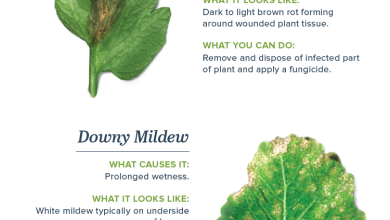
![Photo of Pests and Diseases of Garlic: [Detection, Causes and Solutions]](https://www.complete-gardening.com/wp-content/uploads/2022/08/pests-and-diseases-of-garlic-detection-causes-and-solutions-390x220.png)
![Photo of Complex Fertilizers: [Characteristics, Effect, Obtaining and Application]](https://www.complete-gardening.com/wp-content/uploads/2022/08/complex-fertilizers-characteristics-effect-obtaining-and-application-390x200.jpg)
